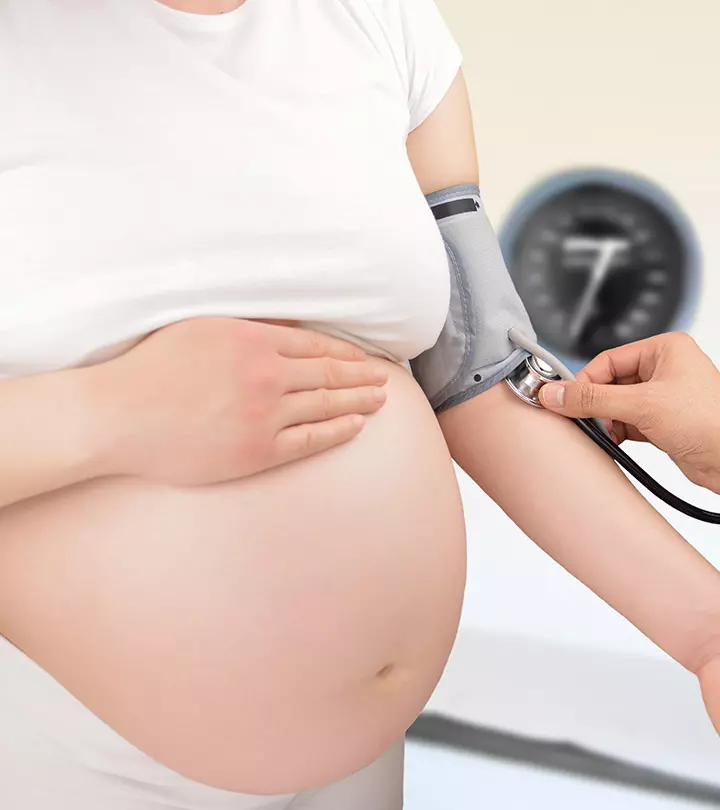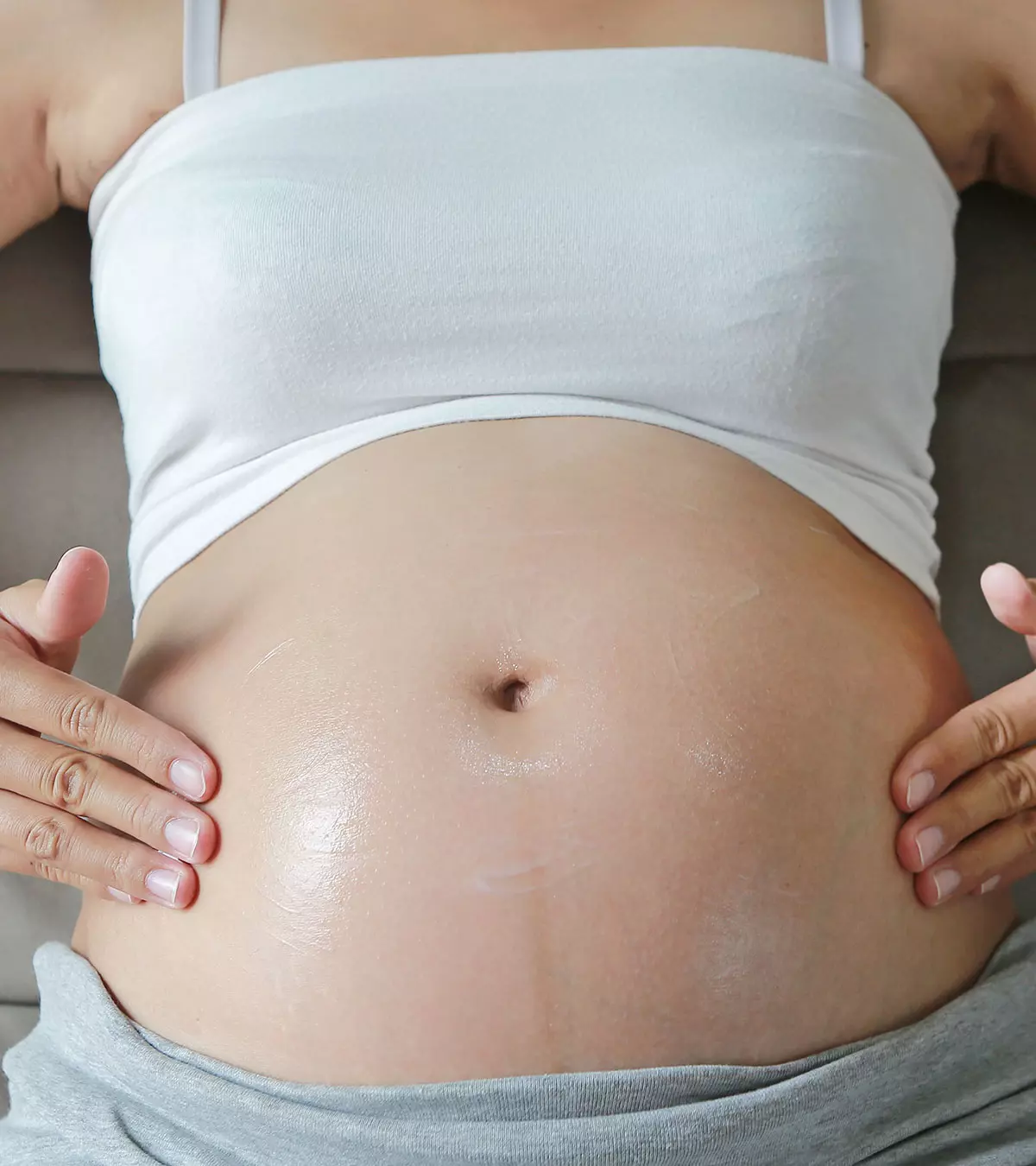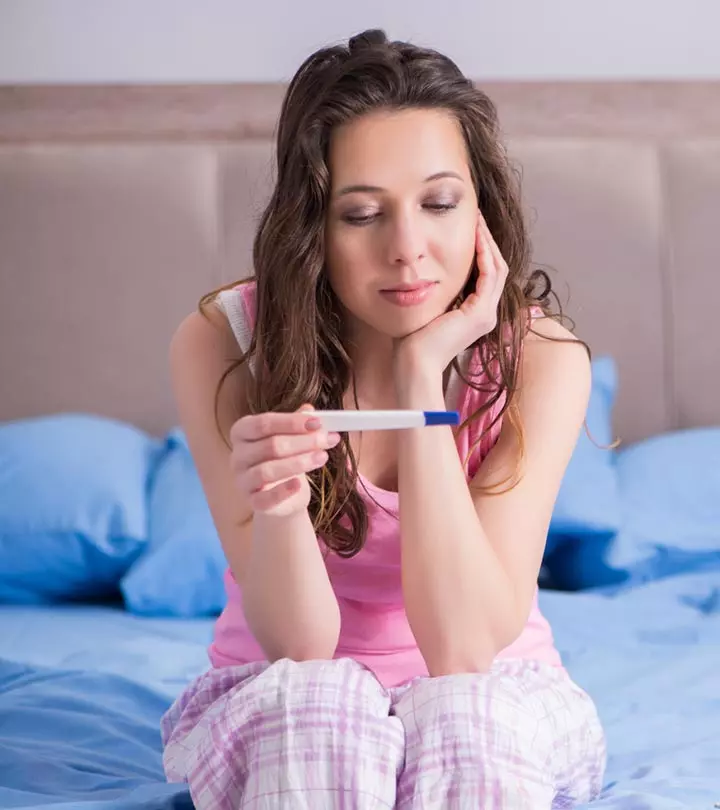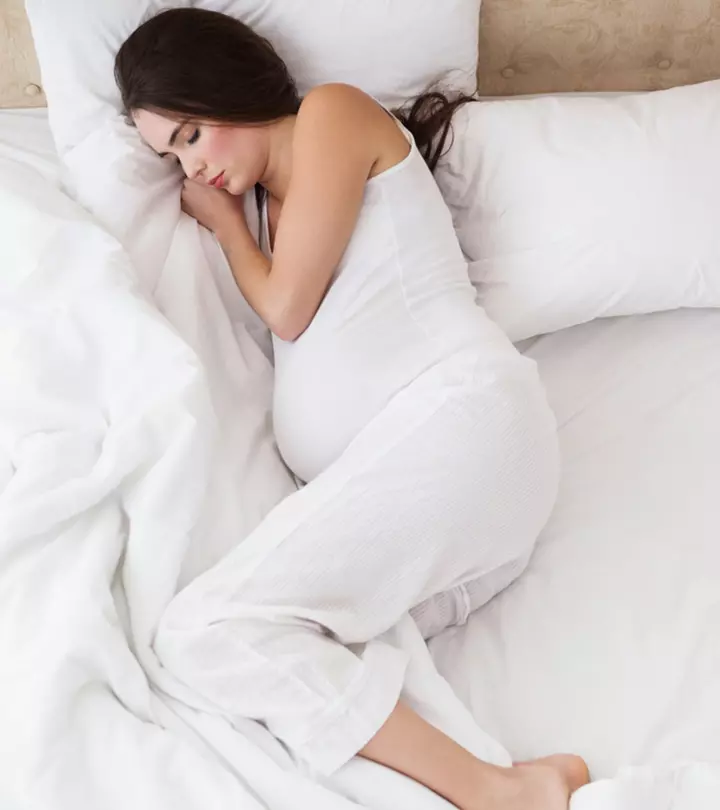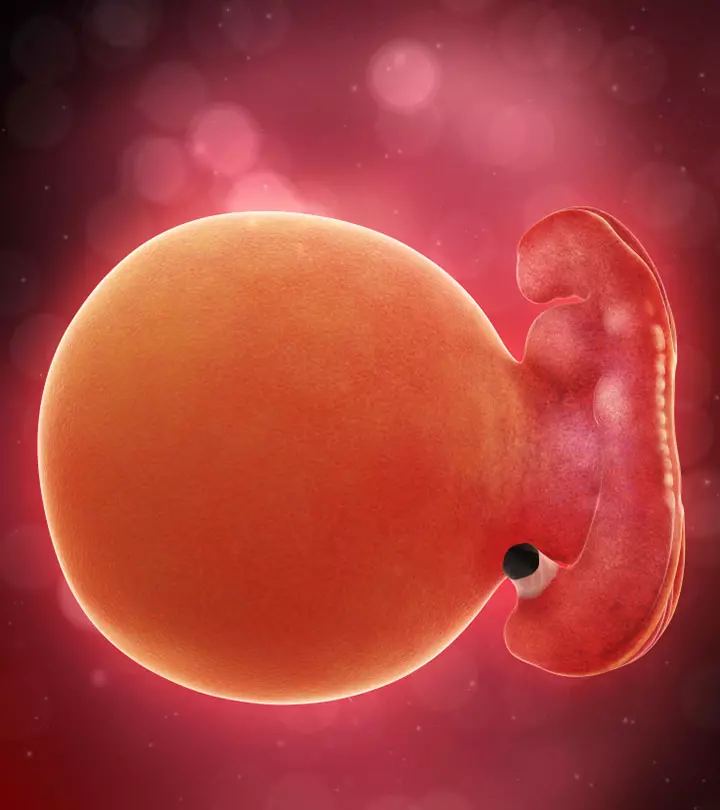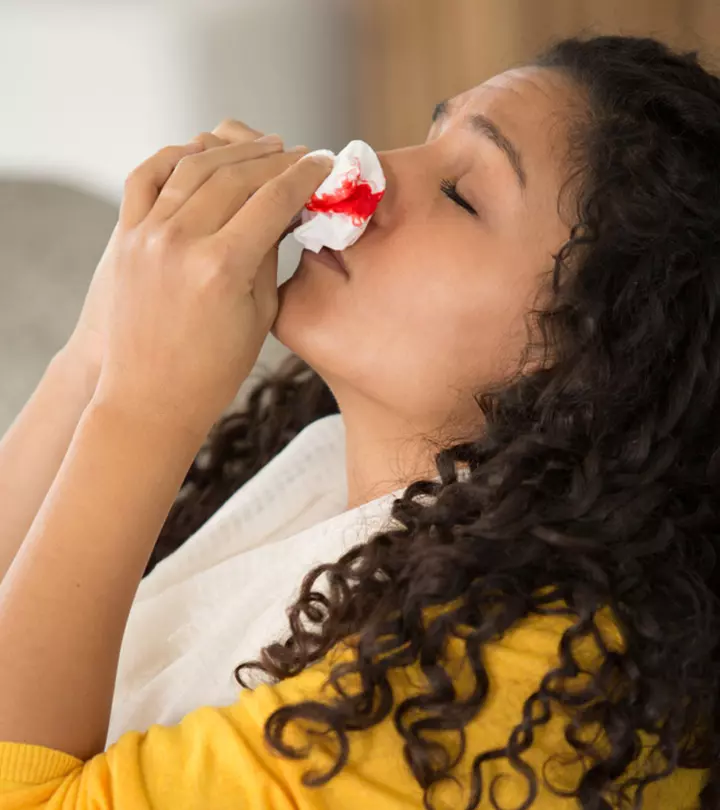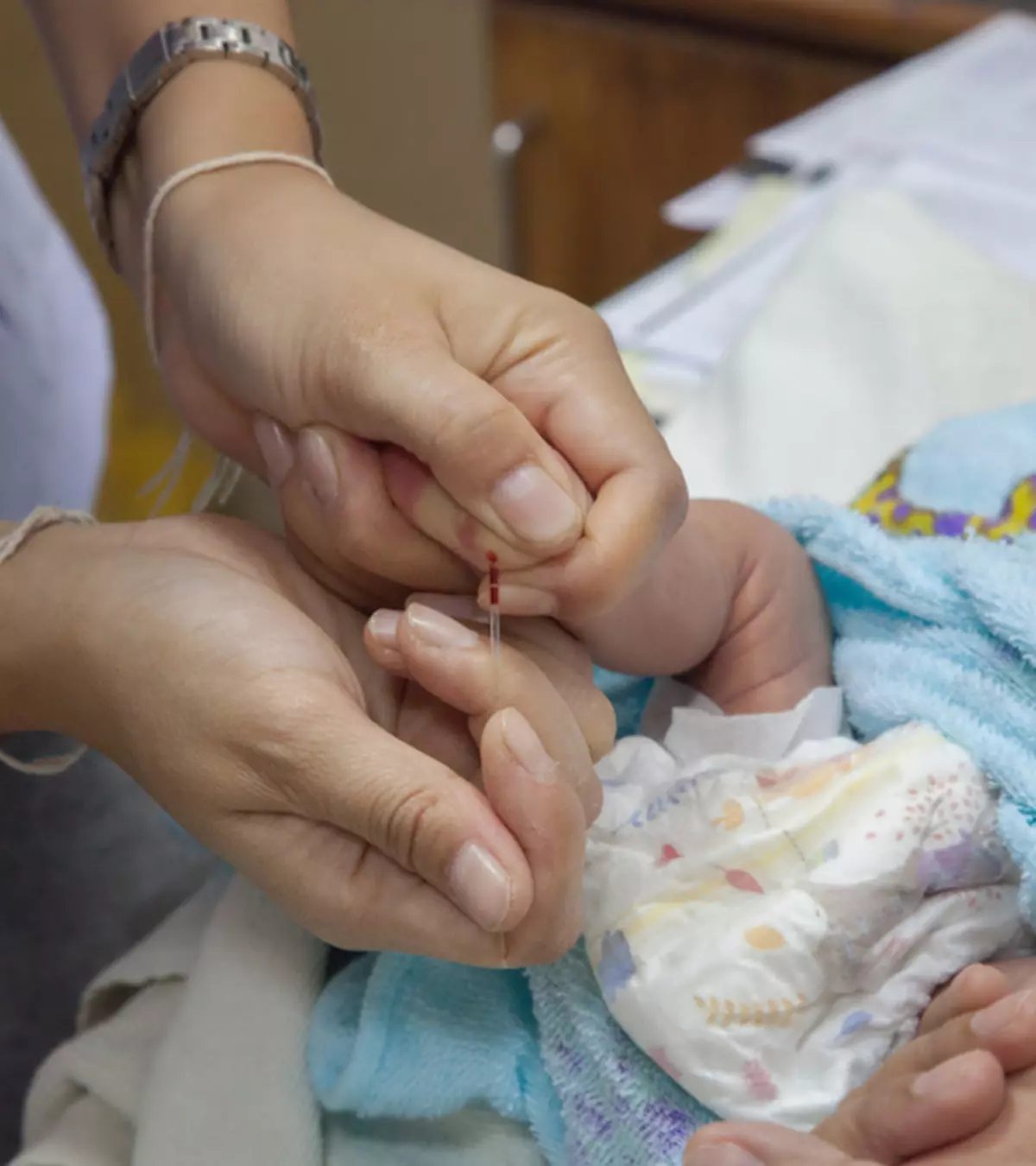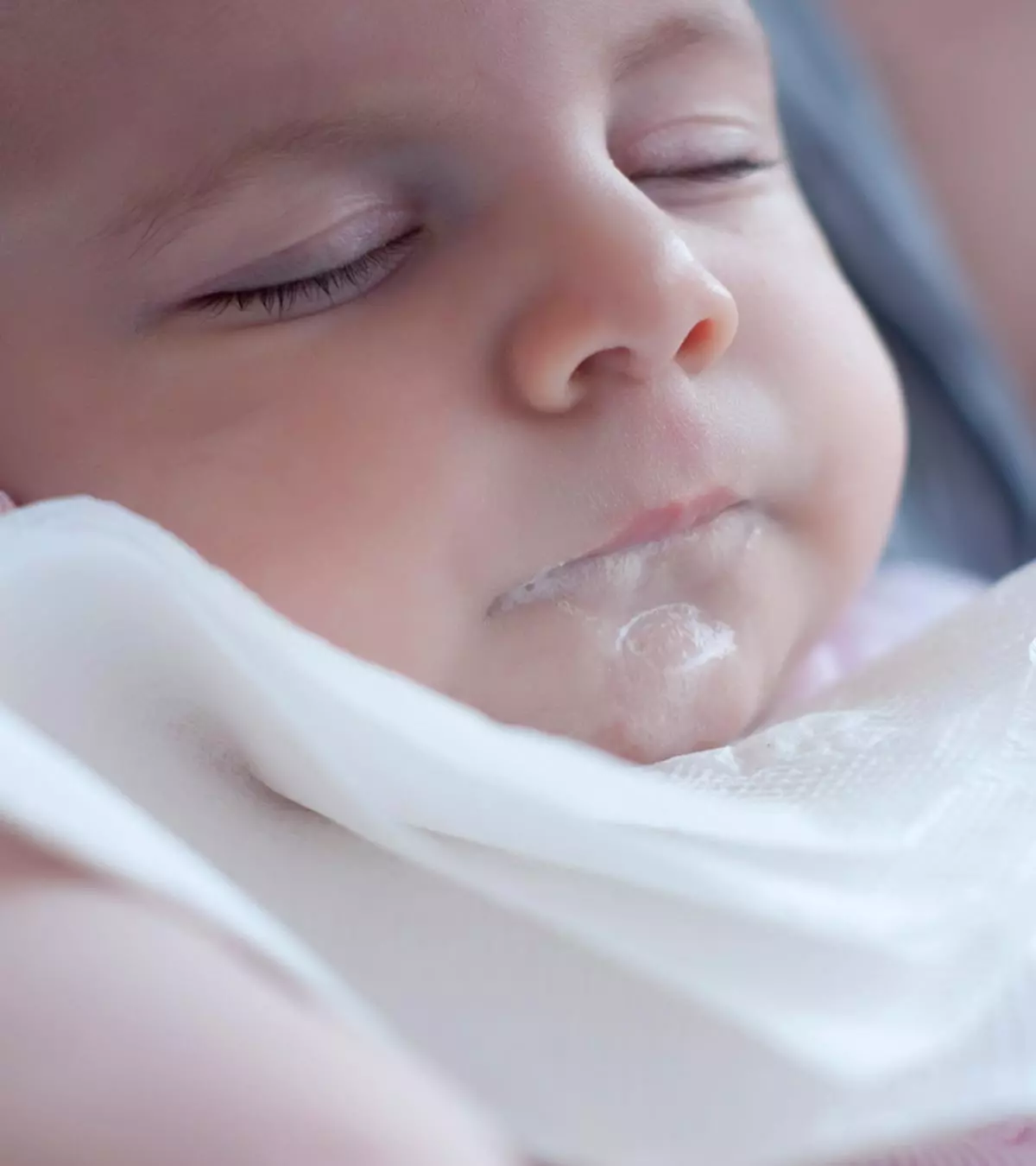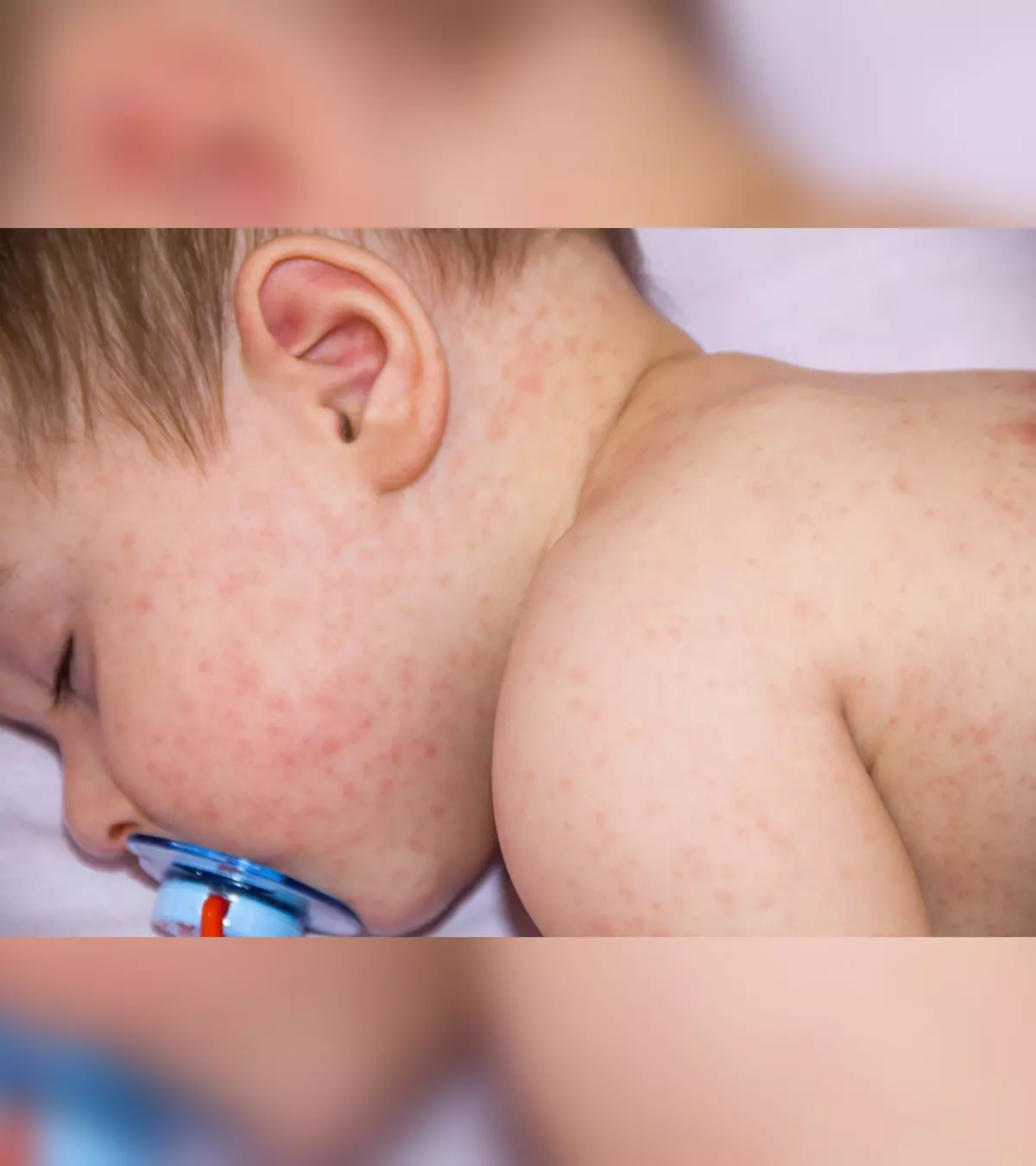
Image: ShutterStock
Fever and skin rashes can be present in many infectious diseases, and it is more common in children than adults. Despite the rashes, a toddler may appear well. These rashes can be due to immune reactions of the body towards the virus or other pathogen. A skin rash during fever can be more serious than a rash developing after fever. Sometimes bleeding spots may be confused with rashes.

Read this post to learn about the various infectious diseases that cause skin rashes in toddlers after a fever.
Key Pointers
- Skin rash after the fever is a common occurrence in children.
- Roseola, Hand, foot, and mouth disease (HFMD), and Fifth disease may cause rashes in babies and toddlers after fever.
- Viral rashes after fever subside with basic home care practices, such as optimum hydration and sponge baths.
- Medical intervention is necessary in case of high-grade fever, the rashes are worsening, or are staying longer than usual.
Causes Of Rashes After Fever In Toddlers
Dr. Loretta Cody, a board-certified pediatrician from New York City Metropolitan Area, says, “Many viral illnesses in children can be associated with a rash. This is called a viral exanthem. Some of the common viral illnesses associated with a rash in toddlers are coxsackie, chickenpox, erythema infectiosum also known as Fifth disease, and roseola. The viral rashes can appear from red bumps and blotches to itchy fluid-filled blisters as seen with chickenpox. Many viruses associated with a rash are diagnosed by the appearance of the rash.”
The following conditions may be responsible for the appearance of rashes after fever in toddlers.
The following conditions may cause rashes in toddlers after a fever.
1. Roseola
Roseolainfantum, also called the sixth disease, three-day fever, exanthemsubitum, or pseudo-rubella, is common in toddlers. This is caused by human herpesvirus-6 (HHV-6) (1). Another strain of herpes virus, herpesvirus-7, may also cause roseola in toddlers in rare cases.
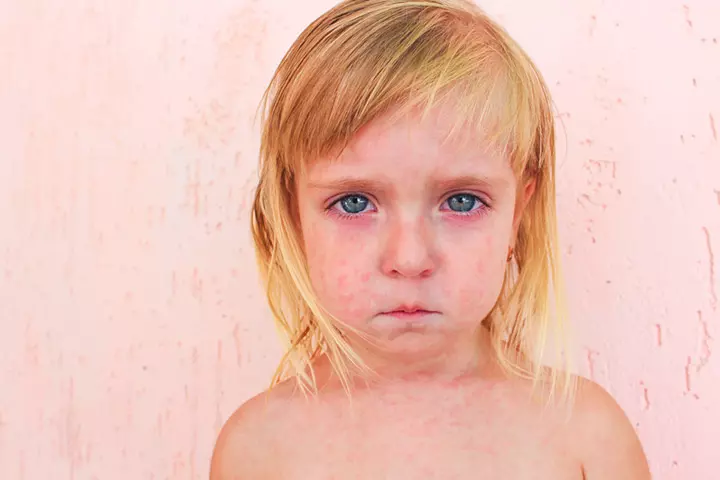
Fever in roseola: The infection may begin with a high fever, often ranging from 102°F to 105°F (38.8°C to 40.5°C) in children below two years of age. The fever may last for three to seven days and often present with the following symptoms.
- Diarrhea
- Cough
- Runny nose
- Lack of appetite
Rash in roseola
: The skin rashes appear after the fever subsides, usually 12 to 24 hours after the fever. This is the difference between roseola and measles. In measles, the fever spikes as the rashes appear whereas in roseola, the appearance of rashes coincides with remission of fever. Slightly raised pink rashes on the belly, chest, and back of the body are seen in roseola. Roseola is not diagnosed until rashes appear, and most toddlers are no longer contagious 24 hours after the fever resolves. The rash may last for one to three days, and most children are fine by the time the rash appears.
Treatment for roseola: There is no specific treatment for roseola in toddlers, and the condition may run its natural course. However, it is recommended to seek pediatric care for fever spikes since it may cause febrile seizuresiFits in children caused by fever in some toddlers.
An anonymous blogger who goes by the name ‘Cornyman’ shares how his toddler developed a rash after a fever. He says, “Roseola Infantum infected Timmy, and he suddenly had a very high fever after we came back shopping. During the fever, it wasn’t easy to make him sleep, and he cried very often…About two days later, the fever was gone, and the rash appeared for the first time on his head. Initially, we thought it was some bites from ants (at that time, we did not know about Roseola Infantum). But the rashes showed up more and more. It covered the neck, slowly to the chest and back, finally his arms and legs were covered (i).”
2. Hand, foot, and mouth disease (HFMD)

Hand, foot, and mouth disease (HFMD) is a viral illness caused by viruses belonging to the enterovirusiA group of viruses causing infections with symptoms such as body aches, fever, cough, skin rash, runny nose, mouth blisters, etc. family. Coxsackievirus A16, coxsackievirus A6, and enterovirus 71 (EV-A71) are common viruses associated with HFMD in toddlers. Most children may get HFMD by five years of age (2) (3).
Fever in HFMD: This disease may begin with mild fever, sore throat, and lack of appetite in toddlers. Painful mouth sores are seen one or two days after the fever. These sores may begin as small red spots and become blistersiA small yet painful fluid-filled pocket between the upper layers of skin. . Fever may subside within three days in most toddlers. Eating or drinking issues due to painful swallowing and drooling are also seen in HFMD.
Rash in HFMD: Toddlers may develop red spots on the palms and soles. The itching rashes may spread to the buttocks, limbs, and genital area in severe cases. The rashes initially look like raised red spots, but later become blister like in appearance.
Treatment for HFMD: There is no specific cure for HFMD, and it may resolve within seven days after running its natural course. Children may require fever medications and hydration to prevent dehydration. Severe infection may affect fingernails or toenails, causing them to fall off. You may consult a pediatrician or pediatric dermatologist in such cases (4).
Sarah, a mother of three, recalls how her youngest son had a surprising episode of HFMD rash that disappeared on its own. She writes, “My youngest had been a little under the weather but nothing notable, we were at a mums and tots session, and he was complaining his feet hurt, I took off his shoes and noticed a few small red spots appearing, I gave his feet a rub, he seemed ok, put his shoes and socks back on and within 10 minutes he was crying again about his feet, again I took his shoes off and his little feet were now covered in these spots, they were appearing before my eyes which I think was due to the heat, and then I noticed he was getting them on his hands, I had no idea what it was, showed the play leaders and they also were unsure of what it could be, so I took him to the chemist, who said it was HFM and there was no real need for treatment, Mikey was uncomfortable with the spots only when he had socks and shoes on, other than that they didn’t bother him, and within a few days they had gone, he never got any on his face and only one small white spot in his mouth. The most concerning things was the rate the spots appeared, as spots always seem to conger up thoughts of meningitis which we all know we have to be so vigilant about (ii).”
3. Fifth disease
Fifth disease, also known as erythema infectiosum or slapped cheek disease, is a mild rash-causing viral illness due to parvovirus B19. Bright red rash on the cheeks gives the name “slapped cheek disease,” and the other name, the fifth disease, comes from an order of old classifications of viral skin rash diseases in children (5).
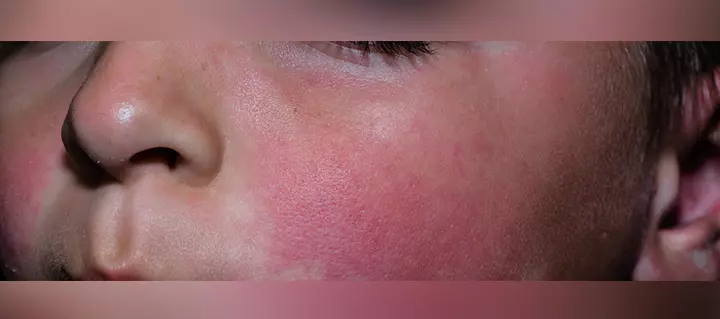
Fever in the fifth disease: Cold-like symptoms such as runny nose followed by mild fever is characteristic of this condition. Fever may last seven to ten days, and children are contagious during this time.
Rash in the fifth disease: Rosy cheeks may appear as “slapped cheek” or “slapped face” and are usually seen seven to ten days after fever. This rash can be slightly raised with lace-like patterns and often spread to the body and limbs. Fifth disease rash often disappears in seven to ten days. In some toddlers, the rash may come and go for several weeks in various parts of the body. Fifth disease is more a disease of the older children than toddlers.
Treatment for the fifth disease: This is a mild childhood illness that goes away without specific treatments. Healthy children may recover without complications. However, if your child has any health condition, the symptoms may worsen, requiring medical care.
Many other diseases, such as measlesiA contagious airborne viral infection that causes a fever, runny nose, and rash. and scarlet feveriAn infection caused by the group A streptococcus bacteria causing a red, bumpy rash all over the body. , can cause skin rashes and fever in toddlers. However, these conditions may usually cause fever during the onset of skin rash. Although it is possible to have skin rash after seven days of illness in scarlet fever, this condition is rare in toddlers due to maternal antibodies. Also, in dengue, sometimes after the fever subsides, red, flat, non blanching rashesiRashes caused by bleeding of blood vessels under the skin and do not disappear when pressed may appear which are bleeding spotsiBroken blood vessels or blood collecting under skin tissue in larger areas, also known as purpura . These children should immediately be taken to their doctor.
 Quick tip
Quick tipHome Management Of Skin Rashes After Fever
Pediatrician Dr. Raashid Hamid says, “Proper hydration and nutrition play a key role in recovery from infections that cause post-fever rashes. Ensuring the child drinks plenty of fluids and eats nutrient-rich foods can support their immune system and promote faster healing.” Most viral illnesses require time to run their course, and most toddlers feel better after the fever ends. After fever, viral rashes in babies and toddlers may not require treatment since they fade away in a short time. You may try the following home care measures during these illnesses to ease the symptoms.
- Provide hydration: Give plenty of fluids to your toddler during febrile illnesses to prevent dehydration. You may give clear fluids such as water, clear broth, diluted fruit juices, coconut water and oral rehydration solutions, to the toddler to replace water and electrolyte loss. Toddlers who breastfeed should continue to breastfeed as usual.
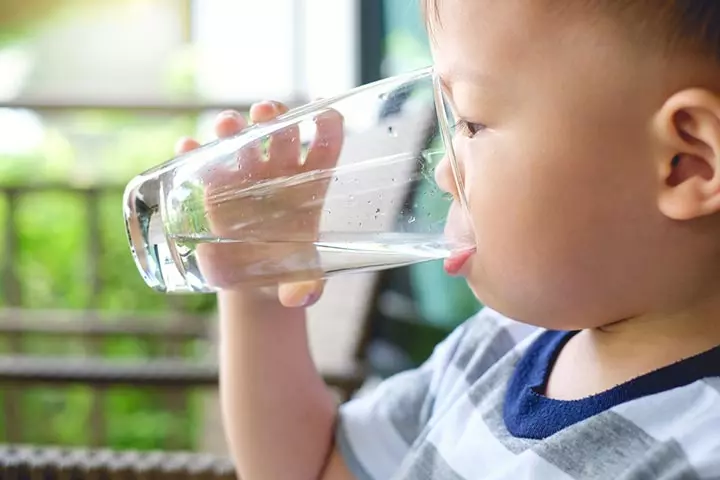
- Ensure plenty of rest: Make sure your toddler is getting enough rest and sound sleep during illness since it could aid in recovery.
- Sponge baths: You may clean your toddler with a cool washcloth or lukewarm sponge bath during fever to prevent chills and discomfort due to bathing. It is better to avoid cold water, ice packs, and cold room temperature during febrile illnesses in toddlers. A lukewarm water bath may be given.
- Medications: You may give fever medications to the toddler as per the doctor’s directions. You may also consider skin medications and lotions as per the doctor’s recommendations to relieve any rash-related skin irritation in the toddler. For oral ulcers, soothing gels might be applied on a doctor’s prescription only.
- Soft and cold foods: Sore throat, mouth ulcers, and rashes around the mouth may make it difficult for a toddler to swallow and chew food. Soft food items, such as vegetable mash, or liquid-based food items, such as smoothies and soups, brought to room temperature, could be ideal options during this phase. Good nutrition during illness is important to bring the child back to his pre-illness health. Since consumption is decreased during illness, more frequent and calorie dense feeding may be given. This may be achieved by adding oil or ghee to each feed.

While you take care of the toddler, ensure your safety. To prevent the spread of rashes and allergic reactions, washing your hands with soap and water before and after touching the child during these illnesses is vital.
 Quick tip
Quick tipWhen To See A Doctor?
You may contact the pediatrician if your toddler has a fever lasting for more than three days or has a high temperature. Rashes after fever in toddlers can be managed at home as per the doctor’s suggestions. However, worsening redness or rashes lasting longer than usual could require medical care. Board-certified diplomate of the Philippine Pediatric Society, Dr. Maria Carmela Villania-Mamauag, advises, “Contact a healthcare provider if the child has signs of dehydration, is very irritable, doesn’t tolerate food or medications, has other symptoms such as swollen, painful lymph nodes, conjunctivitis, changes in sensorium, abdominal pain, bleeding, chest pain, etc.”
Any non-blanching rash, or any rash accompanied by other bleeding manifestations or pus drainage, should be also immediately brought to a doctor’s notice (13).
 Quick tip
Quick tipFrequently Asked Questions
1. Is a viral rash contagious in toddlers?
Yes, a viral rash in toddlers can be contagious, as it can be caused by a viral infection that is spread from person to person. However, the exact contagion potential depends on the rash’s underlying cause and the transmission method. It is best to consult a healthcare professional for a proper diagnosis and guidance on managing the inflammation and reducing its spread. It is recommended not to send toddlers to daycare until they recover (8).
2. Does respiratory syncytial virus (RSV) cause a rash in toddlers?
No. RSV is a severe viral respiratory infection that causes symptoms such as fever, runny nose, and sneezing in toddlers; however, it does not cause rashes (9).
3. What can I do to prevent my toddler from getting a rash after a fever?
It may or may not be possible to entirely avoid a rash after a fever. However, you may continue to take a few general precautions. These include baths with oatmeal, cool compresses, lightweight or loose-fitting cotton clothes to prevent overheating and heat rash, and adequate hydration (10) (11).
4. Can rashes appear without a fever in toddlers?
Yes, your toddler may develop rashes without fever in many skin conditions. These conditions include cellulitis, eczema, impetigo, hives, and other allergic skin reactions and disorders (12).
Roseola, HFMD, and the fifth disease can cause skin rashes after fever in toddlers. The rashes often appear 12 to 24 hours after the fever subsides. Usually, doctors can diagnose the condition based on the type of rash and area involved. Though the symptoms may go away without specific treatment in most children, you may seek medical care if the rashes worsen. Further, supportive therapies to reduce or relieve the symptoms may be offered. Adequate hydration, sponge baths, rest, and a nutritious diet are essential while recovering from infectious diseases.
Infographic: Symptoms To Identify Diseases That Cause Fever And Rash
Several illnesses may cause fever with rashes. However, certain additional symptoms may assist in quick diagnosis. Go through the infographic below that lists such accompanying symptoms.
Some thing wrong with infographic shortcode. please verify shortcode syntax
Personal Experience: Sources
MomJunction articles include first-hand experiences to provide you with better insights through real-life narratives. Here are the sources of personal accounts referenced in this article.
i. 3-Day-Fever: The 1st severe viral infection for our son;https://babyandkidsworld.blogspot.com/2010/04/roseola-infantum.html
ii. The ugly truth to being a parent;
https://thisisme-sarahmumof3.blogspot.com/2011/05/ugly-truth-to-being-parent.html
References
- Roseola-Viral Rash; Seattle Children’s Hospital
https://www.seattlechildrens.org/conditions/a-z/roseola-viral-rash/ - HFMD: Causes and How It Spreads; Centers for Disease Control and Prevention.
https://www.cdc.gov/hand-foot-mouth/causes/?CDC_AAref_Val=https://www.cdc.gov/hand-foot-mouth/about/transmission.html - About Hand, Foot, and Mouth Disease.
https://www.cdc.gov/hand-foot-mouth/about/index.html - Hand-Foot-and-Mouth Disease- Viral Rash; Seattle Children’s Hospital
https://www.seattlechildrens.org/conditions/a-z/hand-foot-and-mouth-disease-viral-rash/ - About Parvovirus B19; Centers for Disease Control and Prevention.
https://www.cdc.gov/parvovirus-b19/about/index.html - Roseola infantum; Australian Government Department of Health
https://www.healthdirect.gov.au/roseola-infantum - Viral Exanthem Rash; Cleveland Clinic
https://www.healthdirect.gov.au/roseola-infantum - Rashes; The Royal Children’s Hospital Melbourne
https://www.rch.org.au/kidsinfo/fact_sheets/Rashes/ - RSV in Children and Adults.
https://my.clevelandclinic.org/health/diseases/rsv-respiratory-syncytial-virus - 12 Common Summertime Skin Rashes in Children.
https://www.healthychildren.org/English/health-issues/conditions/skin/Pages/Common-Summertime-Skin-Rashes-in-Children.aspx - When Your Child Has Heat Rash (Prickly Heat).
https://www.saintlukeskc.org/health-library/when-your-child-has-heat-rash-prickly-heat - Skin Rashes in Children.
https://www.nhsinform.scot/illnesses-and-conditions/skin-hair-and-nails/skin-rashes-in-children/ - How to Care for Your Child with a Viral Skin Rash.
https://www.sidra.org/sites/default/files/inline-files/Viral%20Rash%20-EN%20.pdf
Community Experiences
Join the conversation and become a part of our nurturing community! Share your stories, experiences, and insights to connect with fellow parents.
Read full bio of Dr. Shaon Mitra
- Dr. Raashid Hamid is a consultant in the department of Pediatric Surgery at GMC hospital and associate professor of Pediatric and Neonatal Surgery at SKIMS, Jammu & Kashmir, India. He has four years of experience and specializes in general surgeries, including appendectomy, cholecystectomy, and exploratory laparotomy.
 Dr. Raashid Hamid is a consultant in the department of Pediatric Surgery at GMC hospital and associate professor of Pediatric and Neonatal Surgery at SKIMS, Jammu & Kashmir, India. He has four years of experience and specializes in general surgeries, including appendectomy, cholecystectomy, and exploratory laparotomy.
Dr. Raashid Hamid is a consultant in the department of Pediatric Surgery at GMC hospital and associate professor of Pediatric and Neonatal Surgery at SKIMS, Jammu & Kashmir, India. He has four years of experience and specializes in general surgeries, including appendectomy, cholecystectomy, and exploratory laparotomy. - Dr. Maria Carmela Villania-Mamauag is a board certified diplomate of the Philippine Pediatric Society with a degree of Doctor of Medicine from Our Lady of Fatima University, Valenzuela City and a Bachelor in Science in Psychology from Saint Louis University, Baguio City which was augmented by a year of Bachelor in Science in Family Life and Child development at the University of the Philippines, Diliman, Quezon City.
 Dr. Maria Carmela Villania-Mamauag is a board certified diplomate of the Philippine Pediatric Society with a degree of Doctor of Medicine from Our Lady of Fatima University, Valenzuela City and a Bachelor in Science in Psychology from Saint Louis University, Baguio City which was augmented by a year of Bachelor in Science in Family Life and Child development at the University of the Philippines, Diliman, Quezon City.
Dr. Maria Carmela Villania-Mamauag is a board certified diplomate of the Philippine Pediatric Society with a degree of Doctor of Medicine from Our Lady of Fatima University, Valenzuela City and a Bachelor in Science in Psychology from Saint Louis University, Baguio City which was augmented by a year of Bachelor in Science in Family Life and Child development at the University of the Philippines, Diliman, Quezon City. - Dr. Loretta Cody is a board-certified pediatrician with over 34 years of experience. She holds an MD from New York Medical College and has practiced pediatrics in Connecticut for many years. In addition to providing care to her patients, she also mentors students pursuing careers in medicine.
 Dr. Loretta Cody is a board-certified pediatrician with over 34 years of experience. She holds an MD from New York Medical College and has practiced pediatrics in Connecticut for many years. In addition to providing care to her patients, she also mentors students pursuing careers in medicine.
Dr. Loretta Cody is a board-certified pediatrician with over 34 years of experience. She holds an MD from New York Medical College and has practiced pediatrics in Connecticut for many years. In addition to providing care to her patients, she also mentors students pursuing careers in medicine.
Read full bio of Dr Bisny T. Joseph
Read full bio of Rohit Garoo
Read full bio of Vidya Tadapatri






